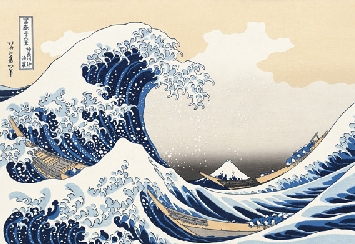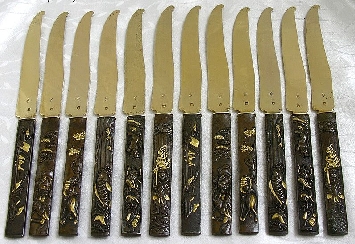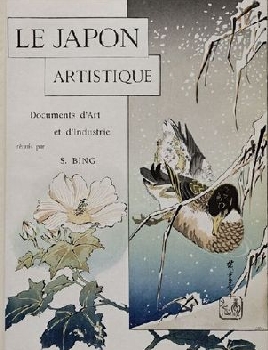Art Nouveau and Japonisme
 Hokusai, "The Great Wave" from the series Thirty-six Views Mount Fuji, 1830Around the same time, the flat-perspective and strong colors of Japanese woodcuts, especially those of Katsushika Hokusai, had a strong effect on the formulation of Art Nouveau's formal language.
Hokusai, "The Great Wave" from the series Thirty-six Views Mount Fuji, 1830Around the same time, the flat-perspective and strong colors of Japanese woodcuts, especially those of Katsushika Hokusai, had a strong effect on the formulation of Art Nouveau's formal language.
The wave of Japonisme that swept through Europe in the 1880s and 1890s was particularly influential on many artists with its organic forms, references to the natural world, and clear designs that contrasted strongly with the reigning taste.
Besides being adopted by artists like Emile Gallé and James Abbott McNeill Whistler, Japanese-inspired art and design was championed by the businessmen Siegfried Bing and Arthur Lasenby Libertyat their stores in Paris and London, respectively.
Siegfried Bing and Maison de l'Art Nouveau
 A set of 12 knives made by Philippe Berthier, circa 1860.Siegfried Bing(1838–1905) was a German art dealer in Paris, who was prominent in the introduction of Japanese art and artworks to the West and the development of the Art Nouveau style in the late nineteenth century.
A set of 12 knives made by Philippe Berthier, circa 1860.Siegfried Bing(1838–1905) was a German art dealer in Paris, who was prominent in the introduction of Japanese art and artworks to the West and the development of the Art Nouveau style in the late nineteenth century.
Bing developed a flourishing import-export business from the 1870s onward, working through several commercial entities with various partners and family members; he concentrated on the importation and sale of Japanese and other Asian objets d'art, though his business also exported French goods to Japan, working through a Yokohama office run by his younger brother August.
In December 1895 he opened his famous gallery, the Maison de l'Art Nouveau, which showed works of artists of what would become known as the Art Nouveau movement. Henry van de Velde designed the interiors of the gallery, while Louis Comfort Tiffany supplied stained glass. Bing's gallery featured entire rooms designed in the Art Nouveau style by his stable of in-house designers.
During the gallery's most successful period, 1896–1902, Bing handled a wide range of artistic work, included fabrics designed by William Morris, glassware by Tiffany, jewelry, paintings, ceramics, stained glass, and furniture in the Art Nouveau style. At its height, Bing's commercial enterprise reached from the Far East to the United States; he dealt with customers ranging from private collectors to major museums, and helped to promote a global art market.
His pavilion at the 1900 Paris World's Fair was especially notable. By this time Bing was the primary European dealer for the Rookwood Pottery Co. of Cincinnati and the Grueby Faience Co. of Boston, as well as the wares of Tiffany.
Bing advanced the careers of a wide range of artists, including Louis Bonnier, Frank Brangwyn, and Edouard Vuillard, the designers Eugène Gaillard, Edward Colonna, William Benson, and Georges de Feure, and the sculptor Constantin Meunier. Bing closed his gallery in 1904, a year before his death, when the fashion for Art Nouveau was already beginning to wane.
 Cover of the French magazine Le Japon artistique (1888) Bing's activities were important, perhaps crucial, to the Japanese influence on Art Nouveau. He published a monthly journal, Le Japon Artistique, which began in 1888 and was collected in 36 volumes in 1891. The journal influenced figures like Gustav Klimt.
Cover of the French magazine Le Japon artistique (1888) Bing's activities were important, perhaps crucial, to the Japanese influence on Art Nouveau. He published a monthly journal, Le Japon Artistique, which began in 1888 and was collected in 36 volumes in 1891. The journal influenced figures like Gustav Klimt.
Wikipedia
 Top
Top Site Map
Site Map References
References About Me
About Me